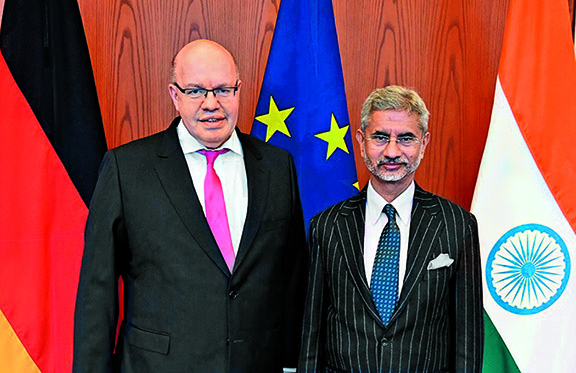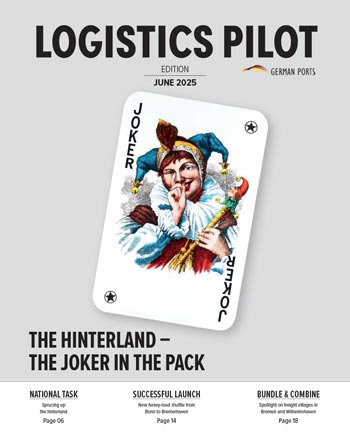A market with almost 1.4 billion people, growth rates of up to eight percent per annum and a young, largely consumption-friendly population – India holds tremendous economic potential. But seizing this potential requires overcoming some hurdles.
Photos: Adani Ports
Other photos: Adani Ports, GTAI, iStock Unreleased/Getty Images/rvimages; DIHK, BMWi/Andreas Mertens
Indo-German economic relations have developed tremendously over the past 15 years: while the bilateral trade volume between the partners exceeded the 10 billion euro mark for the first time in 2006, it had already reached 21.3 billion euro by 2019. This makes Germany India’s largest trading partner in the European Union (EU) and ranks it among India’s ten most important trading partners worldwide. “India is one of the fastest growing economies in the world and offers a wide range of opportunities for German companies. Today more than 1,700 German companies are active in India and the Federal Republic is also the seventh largest foreign direct investor in this country,” emphasises Sonia Prashar, Deputy Director General of the Indo-German Chamber of Commerce in New Delhi. In order to further facilitate the realisation of business opportunities for German companies in India, she emphasises that various programmes such as the “Fast Track System” or “Make-in-India” have been launched in recent years. The Fast Track Agreement, also known as “Single-Window Clearance”, is intended to reduce bureaucratic hurdles and simplify long-standing approval procedures for German companies wishing to invest in India. With “Make in India”, the aim is to appeal above all to small and medium-sized enterprises and to provide incentives for further foreign direct investments, more liberalisation and infrastructure development.
29 federal states, many differences
But other countries have also discovered India and integrated it into their global supply chains. “Today many international companies, including from the automobile and automotive supply industry, machine and plant construction, the chemical and pharmaceutical industry and electronic manufacturing, produce in India”, reports Boris Alex, India expert and director of the German federal business development agency Germany Trade and Invest (GTAI). He believes that India, which has intensified its free market orientation since 2014 under Prime Minister Narendra Modi, is “a dynamic market with high growth potential, but by no means a simple market”. A particular challenge for trade is the country’s geographic expanse, with 29 states and seven Union Territories and often stark differences in language, culture and mentality. Alex completes the description of the situation: “In addition, these regions have a high degree of autonomy with regard to political and economic conditions. This does not make market development any easier”. He adds that India is also a “country of contrasts and extremes”, whose economy has experienced a rapid upswing in recent years, but which has to contend with considerable contrasts: for example, the orientation on both the service sector and on agricultural, or the number of IT experts and the high proportion of illiterates. “The latter social differences are particularly visible in large cities like Delhi, Mumbai or Bangalore,” says Alex. For Prashar, however, these contrasts are not an obstacle to fruitful economic cooperation: “India offers high level skilled labour in various sectors, especially in the IT sector – and Germany has the opportunity to explore this cooperation. During her last visit to India in 2019, Chancellor Merkel also called for more cooperation in the areas of digitisation, innovation, health and agriculture”.

“More than 1,700 German companies are active in India.”
Sonia Prashar, Deputy General Manager of the Indo-German Chamber of Commerce in New Delhi
The port of Haldira is one of India’s Major Ports. It is located some 50 kilometres south of Kolkata, previously called Calcutta.
Infrastructure: India’s Achilles’ heel
When one discusses India with people in the maritime industry or in logistics, they often mention (if discreetly) a “shocking lack of skilled workers” or “pervasive corruption”, in addition to the bureaucratic hurdles and long-standing approval procedures mentioned above. But another problem is much more obvious and concrete: the country’s infrastructure deficits. Alex makes this point too: “The infrastructure remains the Achilles’ heel of India’s economic development. Even if a lot of work has been done in this domain.” Indeed, over the past ten years the Indian government has spent increasing amounts on this sector, amongst others to build new motorways, modernise the railway system and adapt the Delhi and Mumbai airports to international standards. In parallel, in July 2019 an investment programme with a volume of 1.4 trillion euros by 2025 was drawn up, which should include a total of 6,800 infrastructure projects. Specifically regarding the maritime economy, Alex emphasises the significance of another programme, Sagarmala, which since 2015 has set the framework for the modernisation and expansion of the country’s port infrastructure with an investment volume of some 90 billion US dollars. “The programme’s aim is to double the handling capacity of the 60 or so active public ports by 2025 to 3.5 billion tonnes per year. The plan includes the construction of six additional large ports, including in Wadhavan (Maharashtra), Tajpur (West Bengal) and in Enayam and Sirkali (both in Tamil Nadu)”, according to Alex.
Last year, the country’s twelve main ports handled some 70 percent of India’s total cargo volume. The largest among them are Deendayal on the west coast in Gujarat (with 115 million tonnes in 2019) and Paradip on the east coast in Odisha (with 109 million tonnes in 2019). The top five list of the largest ports in the country is completed by JNPT, Visakhapatnam and Mumbai. “It is through these ports that the largest share of mass and bulk cargo and of crude oil is handled”, Alex explains. The third-largest port in this ranking, JNPT, is also the largest container port in the country. In
2019 around half of the national container volume of ten million TEU was handled there. Other important container ports include Chennai and the private port of Mundra in the state of Gujarat.

“India is a dynamic market, but by no means
a simple market.”
Boris Alex, India expert and Director of Germany Trade and Invest (GTAI)
Investments are also being made in the railway system. The Indian Ministry for Railroads wants to kick off some 4,000 railway projects in the next three to five years.
The GST has changed a lot
Anand Devulapalli, Managing Director India, BLG Parekh Logistics, also believes that current reforms in India, in particular those pertaining to the logistics infrastructure, are contributing decisively to the country’s future competitiveness. BLG Parekh Logistics is a common undertaking between the sea port and logistics provider BLG LOGISTICS in Germany and the Parekh Group in India and is specialised in shipping, distribution, warehousing and production logistics (see Portrait, page 22). According to the logistics manager, “the infrastructure is constantly improving”. This is especially true for ports, where it is being rapidly expanded, including with the support of private operators. He cites the “Goods and Service Tax” (GST) tax reform, introduced on 1 June 2017, as a milestone in this regard: “The GST greatly simplified the tax code and so radically transformed the trade in goods.” Since the reform, goods are taxed uniformly across the country. Delays caused by overloaded customs offices and superfluous paperwork are now a thing of the past. Devulapalli offers a concrete example: “Today a truck only needs three to four days to cover the almost 2,100 kilometres between Chennai and Delhi, instead of six to seven days previously. The transshipment time for truck movement has thus been reduced by 20 percent”.
In addition, he notes the consolidation of warehouses and large logistics centres, in particular in the consumer goods, electronics, car and pharmaceutical sectors. In recent years, many new warehouses have been built to similar construction standards as in Europe. Much has also changed with regard to roads and motorways. However, Devulapalli still sees some areas that need to be addressed. For instance, there is room for development in the inner waterways: “They have a tremendous potential, which will surely be tapped into more deeply in the coming eight to ten years.”
Hope despite the coronavirus and delays
For the coming six to twelve months, Alex of GTAI believes the coronavirus pandemic will be the greatest challenge facing India – both socially and economically. “The first objective is to maintain the health system and to prevent millions of people from slipping into poverty. At the same time, India needs to restart its economy as quickly as possible”, says Alex. “I believe that many of the infrastructure projects cited above will be delayed by at least six to twelve months in the wake of the pandemic. But even without this crisis, the expansion of the ports and of the multimodal logistics centres was already subjected to delays.” However, Alex believes that a consequence of the pandemic will be that many international companies will review their supply chains and possibly diversify them more in the future. “India hopes to benefit from this process through increased local production and a tighter integration into global supply chains, or even by attracting new investors to the sub-continent”, Alex predicts.
Prashar too, despite or even because of the coronavirus pandemic, is vigorously campaigning for the promotion of Indo-German activities: “The world order is in a state of constant evolution and therefore the strong cooperation between the two countries should only be further encouraged, in order for them to leverage each other’s strengths. With India, Germany and the world can count on a robust, stable and technologically equipped partner in the coming years.” (bre)
Logistics Pilot
The current print edition - request it now free of charge.
India’s ports already contribute significantly to increasing the country’s competitiveness. The government now wants to accelerate this process through further reforms.
Bremen and Lower Saxony confirm the trend for Germany
In 2019, bilateral trade between Germany
and India achieved a volume of 21.3 billion euros. German exports to India amounted to 11.9 billion euros, while imports from India were valued at 9.4 billion euros. In the ranking of Germany’s trading partners, India is therefore in 23rd place for exports and in 27th position for imports – a trend that is also reflected in Bremen and Lower Saxony. These figures show that India may be an important trading partner, but it is still a long way from the USA, China, France or the Netherlands.
Top 40 in Bremen
Some 40 Bremen companies currently have a representative or a branch in India. This includes many shippers and logistics companies, but also manufacturing companies in machine and plant construction as well as in research and development. Going on information from the Bremen Chamber of Commerce, a total of 114 companies from the city have regular imports from or exports to India. This places the south-east Asian nation in 37th place among the main trading partners of Bremen. In 2019 the traded goods had an import value of some 103 million euros and an export value of around 129 million euros. The main imports from India were foodstuffs like coffee, fruits, and fish/crustaceans, but also textiles (including shoes) and various articles from the automotive industry. The most in-demand exports included products for chassis and motors as well as measurement and control technologies and electronic goods.
“India is not a simple market. Its domestic market is very large, and so Indian companies are not as dependent on foreign partners and products”, explains Anja Markmann, from the International Department of the Bremen Chamber of Commerce. Furthermore, it is difficult for German companies to establish themselves in India, with failure often due to the bureaucratic hurdles or to the inability to find a suitable and reliable local partner. The high employee turnover in India is another complicating factor.
Among the Top 30 in Lower Saxony
As in Bremen, in Lower SaxonyIndia is not among the leading trading partners. According to the State Statistics Agency of Lower Saxony, between January and July 2020 the country was ranked 27th as country of import and 35th as export destination. In the same period, imports had a value of 430 million euros while exports were valued above 203 million euros.
For the whole of 2019, the figures were 885 million (imports) and 455 million (exports), placing India in 28th position among the major trading partners of Lower Saxony. Rubber goods, shoes, clothing and oil products dominated imports. In exchange, Lower Saxony sent machines (including for the manufacturing and processing of rubber), plastics and chassis, vehicle bodies and motors to India. (bre)
At the start of the year, German Minister for Economic Affairs Peter Altmaier and Indian Foreign Minister Subrahmanyam Jaishankar met in Berlin to explore ways to intensify Indo-German trade relations.
Most read

“The EU and India could
complement one another nicely”
Interview with Melanie Vogelbach, director of the Department for International Economic Policy and Foreign Trade Law at the Association of German Chambers of Industry and Commerce (Deutscher Industrie- und Handelskammertag, DIHK)








